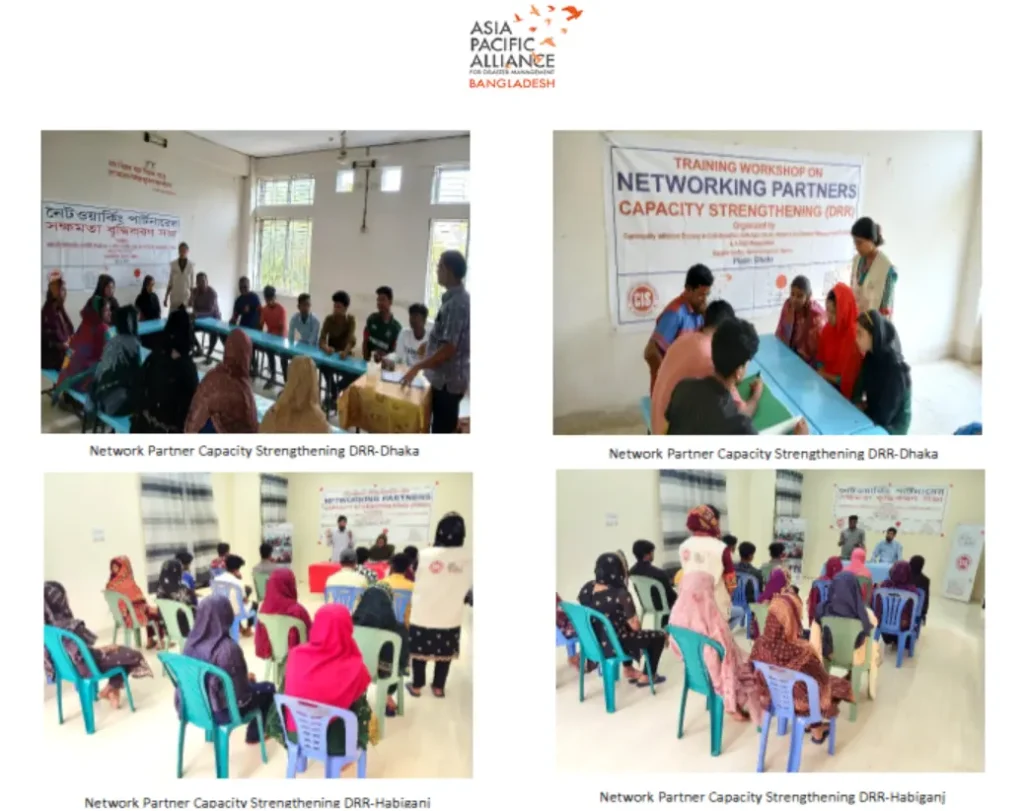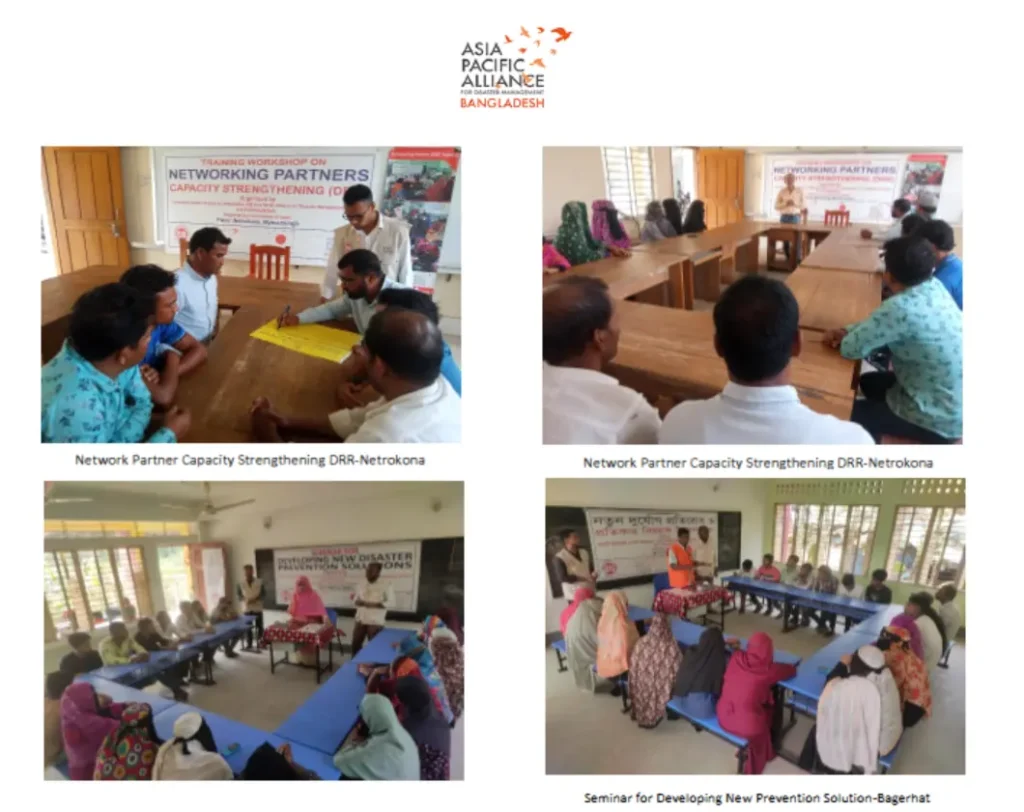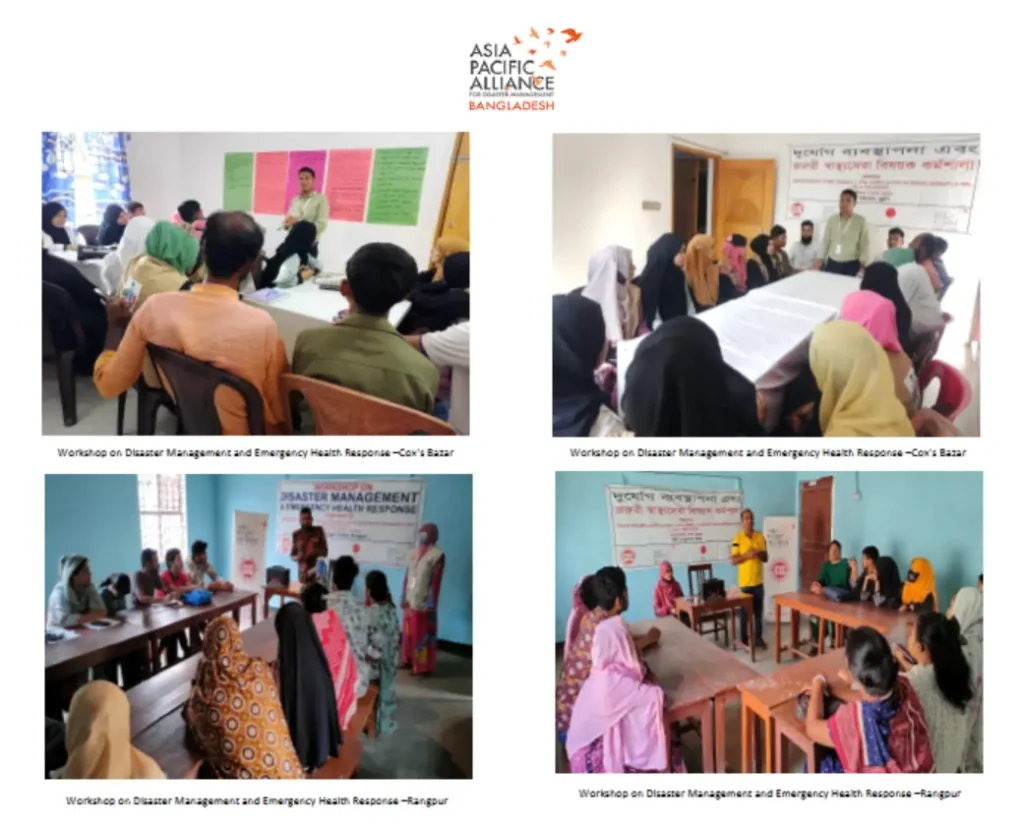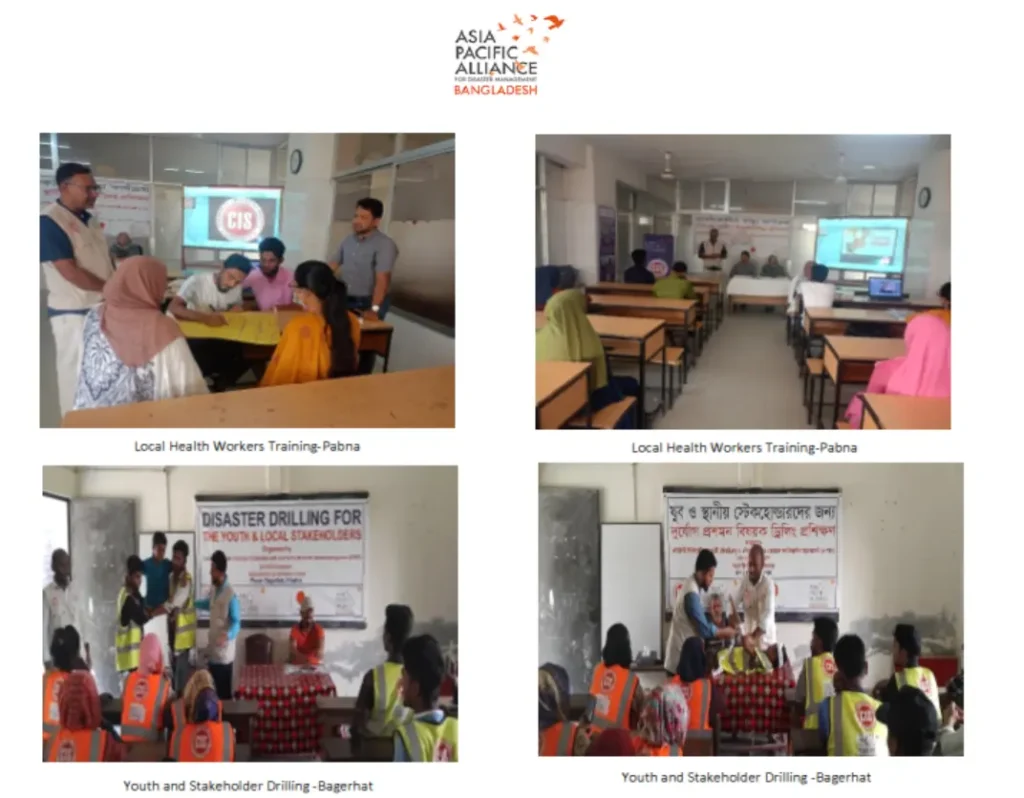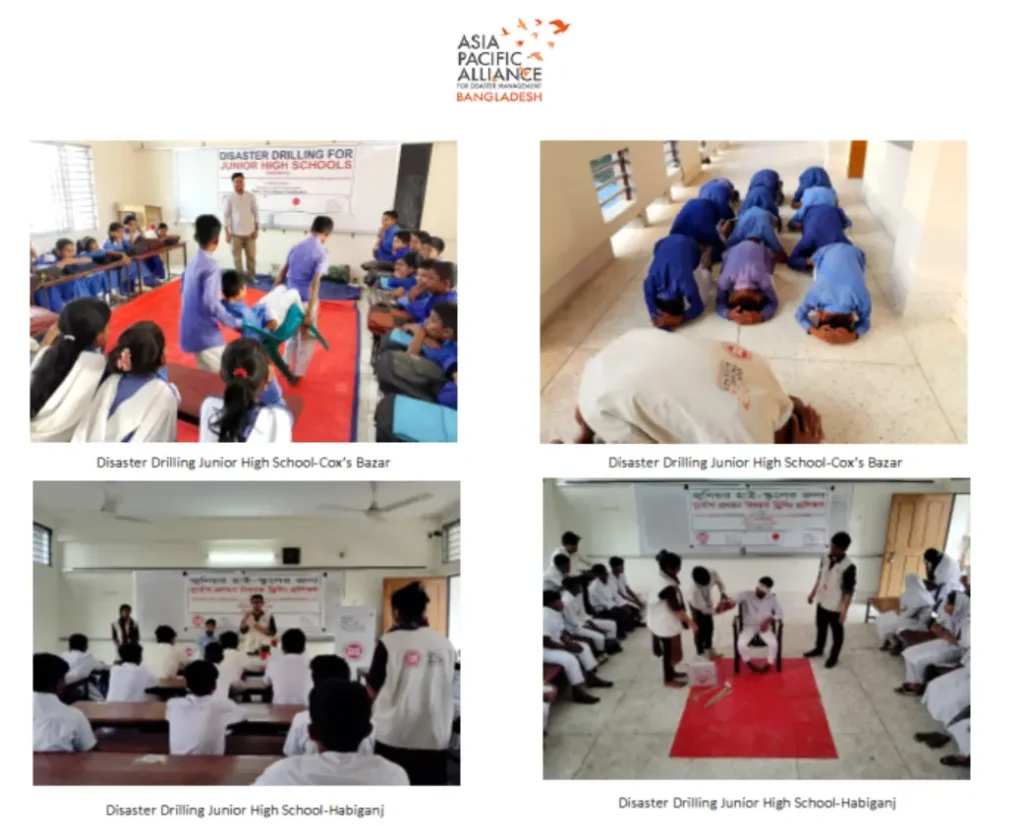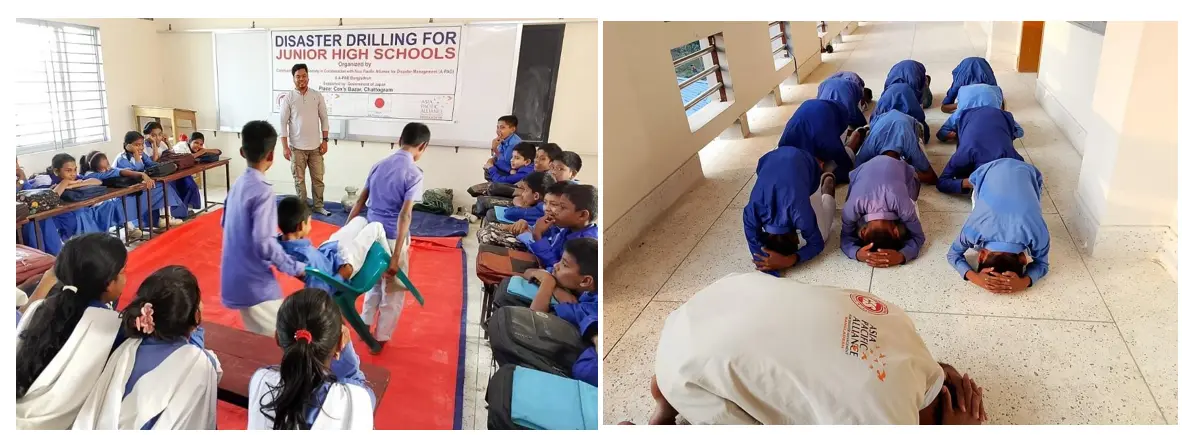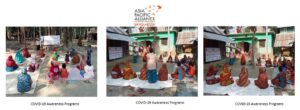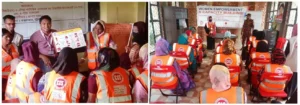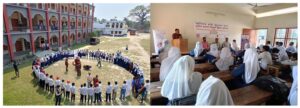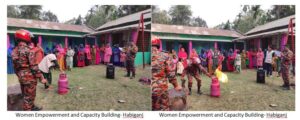Project Title: Strengthening Capacity for Sustainable Disaster Management Network by involving multi-sectoral platform Project Period: 17 January, 2024– 16 January, 2025 (12 month)
- Project Activities and Accomplishments
Bangladesh’s historical narrative, both before and after its independence, is heavily influenced by a range of disasters, largely driven by natural hazards. Situated near the Bay of Bengal, the nation faces the frequent threat of tropical cyclones that originate in the Indian Ocean. These powerful storms intensify as they approach the Southeast Asian region, with Bangladesh being one of the most affected countries. Storms are the most common disaster type encountered by the nation and have historically caused widespread devastation. The geographical makeup of Bangladesh, characterized by its extensive river delta systems and a monsoon climate, significantly heightens the risk of flooding. These floods rank as the second most common disaster affecting the country, often exacerbated by storm surges associated with cyclones. In addition to these challenges, Bangladesh is also vulnerable to landslides that typically occur in the wake of storms and heavy rainfall, alongside other hazards like earthquakes, extreme temperatures, and widespread epidemics that can arise in the aftermath of such disasters. The impacts of climate change are becoming increasingly apparent, further exacerbating Bangladesh’s susceptibility to these hazards.
A-PAD Bangladesh initiated its project in January 2023, with ongoing efforts continuing from January 17, 2025, aimed at enhancing capacity in disaster management. The organization engages with various sectors, including local communities, community leaders, stakeholders, and government officials, through continuous training sessions focused on disaster management. To facilitate these training programs, A-PAD Bangladesh staff organized small community meetings to share insights on disaster preparedness and to introduce participants to the activities of A-PAD Bangladesh. The organization operates across eight divisional areas.
In each division, there is one health worker responsible for conducting home visits to raise awareness within the local community regarding fundamental disaster management issues. These health workers also disseminate crucial information concerning government directives or any disaster-related announcements to the community. As of March 2025, A-PAD Bangladesh has successfully benefited a total of 3,393 individuals.
A-PAD Bangladesh also participated in coordination meetings held in the eight divisions at the Office of the Deputy Commissioner. These meetings included various NGOs that presented their activities and discussed future initiatives in collaboration with government bodies and NGO partners.
1. Strengthening of disaster risk reduction and disaster response system functions through the Emergency Disaster Management Coordination Center | ||
Activities | ( Outcome 1 ) The Emergency Disaster Management Coordination Center operated under this project will function as a disaster response base in each region, leading to the disaster risk reduction in the community and the strengthening of its disaster response system.: | Project Status: Achievements vs Outcome: If the activity is behind the schedule, please write the reason. |
1-1 Operation of Emergency Disaster Management Coordination Centers Target:Local communities 10 people×25 days×8 divisions×12 months =24,000 people | 【Indicators of Outcome】 1-1 The Emergency Disaster Management Coordination Center will be used for coordination meetings among partner organizations and relevant stakeholders during normal times, and will also serve as a center for health and public health guidance for the local residents. In the time of emergency, health services will be provided by emergency health workers. The Emergency Disaster Management Coordination Center will be used by 24,000 local residents (annual average) in the target area. (Indicator:number or visitors, record of services provided) 1-2 Through the Disaster Management Awareness Program, community residents will receive the latest disaster information and knowledge on how to respond to disasters, and people’s awareness of disaster prevention and response will be increased. (Indicator:Community disaster preparedness report) | Total 2,273 people visited to the Disaster Management Coordination Center to discuss about disaster preparedness and health related issues. Dhaka: 260 Persons Cox’s Bazar: 274 Persons Pabna: 290 Persons Bagerhat: 270 Persons Patuakhali: 300 Persons Habiganj: 287 Persons Rangpur: 282 Persons Netrokona: 310 Persons Total = 2,273 Persons |
1-2 Disaster Management Awareness Program Target:Local communities, Community leaders, Local NGOs, Private company workers, government officials 15 people × 8 divisions × 4 times ×12 months =5,760 people | A-PAD Bangladesh conducted Disaster Management Awareness programs at the 8 divisional areas where 497 persons have participated. Total 4 times training organized at each divisional areas. Dhaka:15 Participantsx 4 Sessons= 60+2 =62 Participants Cox’s Bazar: 15 Participantsx 4 Sessons= 60 Participants Pabna: 15 Participantsx 4 Sessons= 60+3=63 Participants Bagerhat: 15 Participantsx 4 Sessons= 60+5=65 Participants Patuakhali: 15 Participantsx 4 Sessons= 60+2=62 Participants Habiganj: 15 Participantsx 4 Sessons= 60 Participants Rangpur: 15 Participantsx 4 Sessons= 60+2=62 Participants | |
Netrokona: 15 Participants x 4 Sessons= 60+3=63 Participants | ||
2. Expansion of disaster management network to improve community vulnerability | ||
(Outcome 2)The network of NPF will be expanded and the capacity of each region for disaster prevention and response will be strengthened. | ||
2-1 Network Partner Meeting Target : Local communities, Community leaders, Local NGO, Private Company Workers, Government officials 50 people × 5 villages × 8 divisions = 2,000 people | 【Indicator of Outcome】 2-1 Strategies, mechanisms, and action plans for disaster reduction cooperation are developed in each region through discussions at network partner meetings, and a framework for disaster reduction cooperation is established. (Indicator:Strategic Plan) 2-2 MOUs signed with at least 5 new organizations, including private companies, in A-PAD Bangladesh NPF to expand the network (Indicator:number of new MOUs signed) 2-4 Resources possessed by A-PAD BGD partner organizations are provided in emergency disaster response, and play the role of that organization in times of emergency. (Indicator:List of resources such as supplies, human resources and donations provided by partner organizations for emergency disaster response) | A-PAD Bangladesh conducted Networking Partner Meeting at Pabna where 250 persons have participated from 5 villages. 05 March 2025, Bhavanipur, Total Participants 50 06 March 2025, Boyara Kashinathpur, Total Participants 50 09 March 2025, Kismatpratappur, Total Participants 50 10 March 2025, Jotkolsha, Total Participants 50 12 March 2025, Patakiabari, Total Participants 50 The Five-Day Networking Partners Meeting in Pabna aims to bring together key stakeholders, including government representatives, ngos, local community leaders, disaster management experts, and development partners, to address the pressing issue of Disaster Risk Reduction (DRR) in Pabna District. This meeting will focus on the unique disaster risks faced by Pabna, explore the role of NGO collaboration, evaluate the current disaster management plans of Bangladesh, and formulate strategies for future disaster preparedness and response. |
Understanding Pabna District and its Disaster Risks o Geographic and demographic profile of Pabna. o Identification of primary disaster risks (floods, river erosion, cyclones, droughts). o Historical overview of major disasters that have impacted the district. o Impact of disasters on the local population, infrastructure, and economy. Local Disaster Experiences and Challenges o Presentation of case studies from the local community on disaster experiences. o Discussion on how local authorities and communities have responded to previous disasters. o Identification of gaps in existing disaster response and recovery efforts. Disaster Management Framework in Bangladesh National Disaster Management Framework o Overview of Bangladesh’s disaster risk management policies, including the National Disaster Management Plan (NDMP). |
o Roles of government agencies such as the Ministry of Disaster Management and Relief (MODMR), local government bodies, and the Bangladesh Red Crescent Society. o A review of the Disaster Management Act and the role of the Bangladesh Disaster Management Bureau (BDMB). Existing Disaster Risk Reduction Measures in Bangladesh o Examination of current DRR programs and initiatives in Bangladesh. o Evaluation of the effectiveness of Bangladesh’s early warning systems, emergency response plans, and community-based DRR activities. o Discussion on the role of local ngos in supporting these efforts. | ||
2-2 Disaster Preparedness Campaigns Target:Partner organizations and local communities 50 people × 2 times × 8 divisions = 800 people | ||
2-3 Network Partners Capacity Strengthening (DRR) | A-PAD Bangladesh conducted Networking Partner Capacity Strengthening DRR at Dhaka, Habiganj and Netrokona where 129 persons have participated from 2 Organizations. |
Target : Partner organizations 20 people × 2 organizations × 2 times × 8 divisions = 640 people | 08-09 March 2025, Netrokona, Total Participants 42 10-11 March 2025, Habiganj, Total Participants 44 23-24 March 2025, Dhaka, Total Participants 43 1. Disaster Risk Reduction (DRR) and Climate Change Adaptation (CCA): DRR and CCA are crucial in a disaster- prone district like Netrakona. The integration of these two concepts is essential for reducing vulnerabilities and enhancing long-term resilience. 2. Emergency Response Preparedness: The training emphasized the importance of being prepared for disasters like heatwaves, floods, fires, and cyclones. It provided practical guidelines on managing these emergencies and helping affected communities. 3. Collaborative Approach: Strengthening the collaboration between NGOs, local government bodies, and the community is key to building a resilient disaster management system. 4. Local Capacity Building: The workshop focused on enhancing local capacities in disaster management, with a special focus on community-level preparedness, response strategies, and recovery plans. 5. Involvement of Various Stakeholders: The training also highlighted the importance of involving various stakeholders (NGOs, government agencies, community |
leaders, and citizens) to ensure the effectiveness of disaster management strategies. | ||
2-4 Seminar for Developing New Disaster Prevention Solutions Target : NGO, Disaster prevention related government organizations, Private sector personnels 30 people ( 2days ) × 8 divisions × 2 times = 480 people | A-PAD Bangladesh conducted Seminar at Bagerhat where 35 persons have participated from 2 areas. 24-25 March 2025, Bagerhat, Total Participants 30+5=35 · Key Points from Sirin Akter Oishi’s Presentation: o Vulnerability to Cyclones: Sirin highlighted that Sarankhola’s flat terrain and low-lying areas make it highly susceptible to flooding, particularly during the monsoon season. These geographical factors, combined with its coastal location, make the Upazila prone to severe impacts from cyclones, including tidal surges and erosion. o Impact of Cyclones: Cyclones often cause significant destruction to infrastructure, agriculture, and homes. During the recent cyclonic events, many communities in the region experienced devastating effects, including floods that submerged houses and farmlands. o Need for Preparedness: Given the recurring nature of cyclones in the region, Sirin emphasized the importance of disaster preparedness and community awareness programs. Understanding the risks and taking necessary precautions can help mitigate the impact of future storms. |
Discussion on Disaster Prevention: · The seminar also focused on developing new disaster prevention solutions, including better forecasting systems, improved early warning mechanisms, and building stronger infrastructure to withstand cyclonic events. | ||
2-5 International Symposium on DRR Target : Government, Local government, private company, NOG, partner organization, representative of A-PAD member countries, etc. 200 people | ||
3. Practical training to improve resilience of local communities | ||
( Outcome 3 ) Contribute to improving the disaster resilience of local communities through practical training. | ||
3-1 Disaster response capacity building of local community level in Health and hygiene field | 【Indicator of Outcome】 3-1 a) Establish networks of community leaders who can lead disaster response and emergency health response in all districts of Bangladesh. (Indicator:Number and the List of community | |
3-1 a) Workshop on | A-PAD Bangladesh conducted Workshop on Disaster | |
Disaster Management and Emergency Health Response Target : Local residents, Community leaders, Local NGO workers 25 people ( 2 days ) × 8 divisions × 2 times = 400 people | leaders for disaster response/emergency health in each 8 districts.) b) Networks of human resources with the skills and know-how to respond to health emergencies will be established in all districts of Bangladesh to provide health services to the local residents in times of emergency. (Indicator:Data of NGO health personals who can respond in emergency. Number of residents who received the services in the cases of activities during emergency disaster in each 8 districts.) 3-2 a) Disaster preparedness training and drills will be documented in a manual, and women, youth groups, and local stakeholders who participate in the drills will be granted certificates of completion and work as disaster volunteer teams during actual disasters. (Indicator:Drilling Manual, Cases of activities in emergency disaster response) b) Disaster drills at junior high schools will be documented in a manual so that students who participate in the drills will have the skills to take appropriate | Management and Emergency Health Response at Cox’s Bazar and Rangpur where 54 persons have participated from 2 areas. 05-06 March 2025, Cox’s Bazar, Total Participants 25+1=26 16-17 March 2025, Rangpur, Total Participants 25+3=28 The key objective of the workshop was to enhance participants’ capacity to provide health services during and after disasters, ensuring that the local community is better prepared for health emergencies. The workshop covered a range of topics related to disaster health activities, emergency health responses, and disaster preparedness. Key Training Topics: · Safety Measures during and after a disaster: Identifying crucial safety steps and practices to ensure the well-being of individuals and the community during emergencies. · Role of CIS and government health workers in managing emergency health situations. · Understanding local disasters: Identifying the common types of disasters in Rangpur (floods, fires, and thunderstorms) and determining appropriate health responses. · Improving self-awareness at the community level: Encouraging local residents to be proactive in |
action in the event of a disaster. (Indicator:Drilling Manual, Report of emergency disaster response) | preparing for disasters and ensuring better community health management. · Calm response during disasters: Learning how to maintain composure and deliver effective health responses during emergency situations. Group Activities and Discussions: At the end of the workshop, participants were divided into smaller groups to discuss and provide feedback on key topics covered during the training. Each group focused on practical aspects of disaster health response, including: · Group 1: Focused on what health measures should be taken during a disaster, such as setting up emergency shelters, ensuring access to safe drinking water, and providing first aid. · Group 2: Discussed necessary steps before a disaster strikes, including public awareness campaigns, emergency preparedness drills, and ensuring the availability of medical supplies. Each group presented its findings, and the session concluded with a discussion on how to improve local disaster health preparedness and response. |
3-1 b) Training of Local Health Workers on Disaster Health Activities Target : Health workers who belong to local NGOs or civil organizations 20 people ( 3 days ) × 8 divisions = 160 people | A-PAD Bangladesh conducted Local Health Workers training at Pabna where 20 persons have participated. 18-20 March 2025, Habiganj, Total Participants 20 Participants The specific objectives of the training were to: · Enhance the understanding of disaster risk reduction and management (DRRM) in the context of public health. · Build the capacity of local health workers to assess, prepare for, and respond to health impacts of disasters. · Strengthen coordination mechanisms between local health units and disaster response agencies. · Conduct practical exercises to simulate real-life disaster scenarios. Community-Based Health Emergency Preparedness and Response refers to the proactive measures and strategies designed to equip local communities with the necessary tools and knowledge to effectively handle public health emergencies. This approach emphasizes the importance of local engagement and collaboration in planning and response efforts. Key components of community-based preparedness include: 1. Risk Assessment: Identifying potential health threats within the community, such as disease outbreaks, natural disasters, or bioterrorism, and evaluating the vulnerabilities of the population. |
2. Training and Education: Providing community members with training on emergency response protocols, first aid, and crisis communication to ensure that individuals are knowledgeable and ready to act during a health emergency. 3. Resource Mobilization: Establishing networks to identify and utilize local resources, including healthcare facilities, volunteer organizations, and community leaders, to build a robust emergency response team. 4. Communication Plans: Developing clear communication strategies that ensure timely and accurate information dissemination to the community. This includes utilizing multiple channels such as social media, local radio, and community meetings. 5. Simulation Drills: Conducting regular emergency drills and exercises to test the preparedness of the community and refine response plans. These simulations help identify gaps in readiness and improve coordination among stakeholders. 6. Partnership Building: Fostering collaborations between local health departments, non-profit organizations, schools, and businesses to create a united front in emergency preparedness. By focusing on community involvement and tailored actions, the Community-Based Health Emergency Preparedness and Response initiative aims to enhance resilience, minimize the |
impact of health emergencies, and protect the overall well- being of the population. | ||
3-2 Strengthening disaster response capacities of local communities through disaster drilling training | ||
3-2 a) Women Empowerment and Capacity Building Target : Women’s groups in target villages 20 people ( 2 days ) × 8 divisions × 2 times = 320 people | ||
3-2 b) Disaster Drilling for the Youth and Local Stakeholders Target:Youth in the local private and civic sector 45 people ( 2 days ) × 8 divisions × 2 times = 720 people | A-PAD Bangladesh conducted Youth and Local Stakeholder Drilling at Bagerhat where 93 persons have participated. 12-13 March 2025, Bagerhat, Total Participants 45+2=47 o Engaging Volunteers: He discussed the importance of engaging local volunteers in disaster preparedness activities. Volunteers play an essential role in spreading awareness, assisting in emergency situations, and helping to organize community response efforts. |
o Building Resilience: Azharul highlighted that disaster drills allow the community to practice and improve response actions. This hands-on training ensures that individuals are better prepared to act in a real emergency, reducing the overall impact of disasters. o Culture of Preparedness: He stressed that drills help foster a culture of preparedness. Through repeated training, people are empowered to take initiative and understand their role in mitigating the impacts of disasters. o Youth as Future Leaders: She emphasized that engaging youth in disaster drills ensures that they are well-equipped with the knowledge and skills necessary to lead future disaster response efforts. This not only strengthens community resilience but also ensures the sustainability of disaster management practices. o Training and Capacity Building: By providing disaster management training to youth, they become active contributors to reducing risks and improving emergency response within their communities. o Inclusion of Local Stakeholders: Purnima highlighted the importance of involving local stakeholders, including community leaders, NGO workers, and volunteers, in disaster drills to improve the community’s collective capacity to respond to emergencies. | ||
3-2 c) Disaster Drilling for Junior | A-PAD Bangladesh conducted Disaster Drilling for Junior High |
High Schools Target:School Children 40 people ( 2 days ) × 8 divisions × 2 times = 640 people | School at Cox’s Bazar and Habiganj where 88 persons have participated. 05-06 February 2025, Pabna, Total Participants 40+5=45 12-13 February 2025, Dhaka, Total Participants 40+3=43 The program began with the registration of participating students. Afterward, the gathering was addressed, and the importance of disaster drills was emphasized. Students were made aware of how the skills learned during the program could be applied to save lives during emergencies. o First Aid Training: Mr. Jahangir Alam provided detailed instructions on how to administer first aid during emergencies. He taught students how to handle basic injuries, apply bandages, and perform fracture management. o Cyclone Emergency Procedures: Mr. Jahangir demonstrated how to use the Cyclone Flag for emergency communication, which is crucial during cyclone events. o Lifting and Handling Disaster Victims: Students participated in a practical session on lifting techniques and how to safely handle victims of disasters without causing further harm. The students were especially appreciative of the live demonstrations and the opportunity to engage in mock drills, which allowed them to experience firsthand what it is like to |
respond to disasters. The hands-on nature of the training reinforced the importance of being prepared and the value of teamwork in emergencies. | ||
3-3 Update website contents as E-resources for Disaster Management | https://apad-bd.org/a-pad-bangladesh-activity-report-month- of-february-2025/ https://apad-bd.org/print-media/ https://apad-bd.org/wp-content/uploads/2025/04/1-1.webp https://apad-bd.org/wp-content/uploads/2025/04/2-1.webp https://apad-bd.org/wp-content/uploads/2025/04/3-1.webp https://apad-bd.org/wp-content/uploads/2025/04/4-1.webp https://apad-bd.org/wp-content/uploads/2025/04/5-1.webp https://apad-bd.org/wp-content/uploads/2025/04/6-1.webp https://apad-bd.org/wp-content/uploads/2025/04/1-2.webp https://apad-bd.org/wp-content/uploads/2025/04/2-2.webp https://apad-bd.org/wp-content/uploads/2025/04/3-2.webp https://apad-bd.org/wp-content/uploads/2025/04/4-2.webp https://apad-bd.org/wp-content/uploads/2025/04/5-2.webp https://apad-bd.org/wp-content/uploads/2025/04/6-2.webp |
- Challenges
Practice in collaboration with A-PAD Bangladesh Network Partners Please write good practice in collaboration with partner organizations
- Any contribution Funds Received and Grants Applied / Planned and Implemented Projects by CIS including Emergency Response
Please write Projects name and its fund resources
- Relationship with Bangladesh Government and Japanese Embassy Please write about Meeting with Government office


